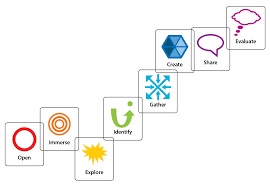
There is a process you can follow every time you’ve got an assignment, which makes it easier and more meaningful for you.
Here it is:

It’s called the Guided Inquiry Design process. It mirrors the way that people of all ages do research, whether they are school or university students, or your mum and dad searching for the best holiday destination, or you wanting to buy a new mobile phone. How do we know it is the way people do research? Because over 30 years of research studies were carried out on this topic by Professor Carol Kuhlthau, from the 1980’s to the present day.
Here is a great overview of the process, created by Diana Brien, Charles Sturt University student, 2021: Guided Inquiry Design
It’s instinctive, it works, and it has the benefit of making what you are researching more interesting to you, because you have chosen the part of the topic you are interested in! Sound good? There are a few things you might not already know about researching that will help you.
You’ll be pleased to know that there are only a few things you need to know about doing an assignment well, staying interested, and on track and being able to pull it all together at the end.
1. Inquiry journal – This is for taking notes.
Regarding notes: DON’T take any at all until you have chosen the part of the topic you are going to explore.
Then, there are many ways of taking notes, and it’s up to you to choose what works for you. Make sure you keep them safely – whether in One note, a print folder, or an electronic one.
Notetaking formats:
2. Inquiry log
There’s no way around this one – it’s for keeping a bibliographic record of the sources you’ve used, in order to go back to those sources should you need to, and because you must present a bibliography with your assignment. Why? It’s all about academic honesty and acknowledging the author in the material you read.
There are not so many ways of keeping a record of your sources, but you should keep what’s needed for the type of referencing you do at your school. What is most important is keeping a record of your sources (useful ones) right from the beginning of your research! This way you avoid that sinking feeling the night before the task is due, oh bibliography, oh no!
Here are some suggestions:
3. Inquiry chart
This is for pulling all your ideas together for whatever it is you have to create at the end of all your research. It can be butcher’s paper, or it can be a mind map, or a drawing. You are asked to look at your notes, your inquiry question, and make a plan in detail. There are online mind mapping tools, like Bubble.us. And the school has Visio, which can be used for creating a mind map.
The three components – Inquiry journal, log and chart – can all be in one document, or not; can be a Word document; can be a handwritten notebook; whatever suits you best. Using Google Classroom or whatever document sharing platform the school has, if you are working in inquiry circles, and for getting feedback during the process, is a good idea.
Here is a template that contains an inquiry journal, log and chart, all in one document. Alter it to fit your needs.